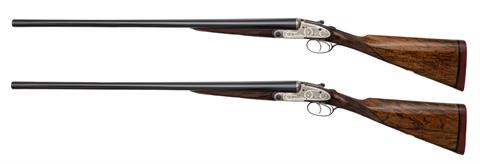
barrel length 71 cm (28"), stock length 36,5 cm (14,25"), overall length 114 cm (45"), choke cylinder & barrel (cyl & cyl), weight 3,0 kg, year of manufacture 1896, british nitro proofing, restored to condition optically 2-3, both with fore-end removed slightly wobbly.
Concave rib engraved with "Joseph Lang & Son, 10 Pall Mall, London", ejectors, bright polished base engraved with fine rose bouquets and arabesques, back-action sidelocks, sear, cocking indicator functional but without indicator, automatic sliding tang safety with gold inlaid "Safe", double trigger, walnut stock, drop points, thick recoil pad, blank gold stock monogram plate, fore-end with Anson push-rod, in a leather case with maker's label.
Originally based in London's New Bond Street, Joseph Lang & Son (founded in 1821) is at the heart of the English gun manufacturing scene. This was expressed not least by the marriage with the daughter of James Purdey or the skill in buying and selling Manton stocks from their bankruptcy. A large number of further developments of the hunting weapons of the time came from the house. In addition to his own gun manufacturing, Joseph Lang set himself a timeless monument by developing the .470 Nitro Express cartridge (1903), a high-performance cartridge for big game hunting. Here it behaved like other areas. Lang was active in the development without putting his own name to it or, like manufacturers with a penchant for marketing, even securing a patent. After more than a hundred years of activity, Lang merged with Stephen Grant in 1912 to form a joint company, and a few decades later with Henry Atkin. The resulting company, Aktin Grant & Lang, still exists today.
Category: Shotguns